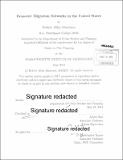Domestic migration networks in the United States
Author(s)
Manduca, Robert Allen
DownloadFull printable version (8.529Mb)
Other Contributors
Massachusetts Institute of Technology. Department of Urban Studies and Planning.
Advisor
Albert Saiz.
Terms of use
Metadata
Show full item recordAbstract
In recent years, there has been substantial interest in understanding urban systems at the national and global scales: what are the economic and social ties that link cities together, and what is the network structure formed by such ties? At the same time, human capital accumulation is increasingly seen as a, primary driver of regional economic growth. Domestic migration patterns have the potential to illuminate the social and economic connections among cities, while also highlighting economically significant flows of human capital. In this thesis I examine the US city system through the lens of gross migration flows, taking advantage of unusually complete data on county-to-county migration compiled annually by the IRS. I compare the observed flows to those predicted by the radiation model. Finding most notably that there are far more long-distance migrants than would be predicted based on the spatial distribution of population alone. I then use reciprocal migration patterns to construct a migration network connecting metro areas in the United States. I utilize current-flow centrality measures to identify the most prominent nodes in this weighted network. Additionally, I use repeated applications of the Louvain community detection algorithm to identify reasonably robust communities within the migration network. These exhibit a striking degree of spatial contiguity.
Description
Thesis: M.C.P., Massachusetts Institute of Technology, Department of Urban Studies and Planning, 2014. Cataloged from PDF version of thesis. Includes bibliographical references (pages 63-67).
Date issued
2014Department
Massachusetts Institute of Technology. Department of Urban Studies and PlanningPublisher
Massachusetts Institute of Technology
Keywords
Urban Studies and Planning.